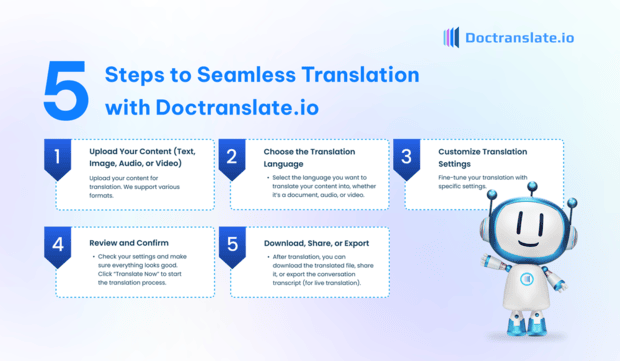Introduction
Translating academic papers is crucial for sharing research globally. Language barriers can prevent important findings from reaching the wider scientific community. Overcoming these linguistic hurdles is essential for academic progress and collaboration.
Academic papers often contain complex terminology and specific formatting. An accurate translation must preserve not only the meaning but also the professional tone and structure. This requires a translation tool that understands the nuances of academic language.
DocTranslate.io offers a specialized solution for translating various content types, including complex documents like academic papers. Its advanced features are designed to handle detailed and technical text efficiently. It ensures your research is accessible to an English-speaking audience.
This guide provides a clear, step-by-step process for translating your academic papers from Spanish to English using DocTranslate.io. Follow these steps to achieve accurate and professional results quickly and easily.
Step-by-Step Guide: Translating Academic Papers from Spanish to English with DocTranslate.io
Step 1: Upload Your Content
The first step involves getting your academic paper into the DocTranslate.io system. Navigate to the document translation section of the website. This is where the translation process begins for files.
You can upload your academic paper using a simple drag-and-drop method. Just click on the file from your computer’s file explorer and drag it into the designated area on the webpage. Release the mouse button to upload.
Alternatively, you can use the traditional file picker. Click the upload button and select your document from your computer’s folders. DocTranslate.io supports common formats like PDF, Word, Excel, and PowerPoint, which are ideal for academic papers.
Ensure your document is ready and saved in one of the supported formats before uploading. The platform is designed to handle various file types smoothly. Uploading is the gateway to breaking down language barriers for your research.
Step 2: Choose the Translation Language
Once your academic paper is uploaded, you need to tell DocTranslate.io which languages are involved. The system often auto-detects the input language, but it’s good to confirm.
Select Spanish as the source language. This confirms that the original text of your academic paper is written in Spanish. Accuracy starts with correctly identifying the starting point.
Next, select English as the target language. This is the language you want your academic paper translated into. Choosing the correct output language is crucial for reaching your intended audience.
DocTranslate.io supports over 85 languages, making it a versatile tool for global communication. Double-check your language selection before proceeding to the next step to avoid errors.
Step 3: Customize Your Translation Settings
For academic papers, customization is key to ensuring a high-quality translation. DocTranslate.io offers settings to refine the output to match your needs.
Based on the reference information, you should opt for a ‘Professional’ translation mode. This mode is designed to handle complex and technical content, ensuring accuracy suitable for academic use.
You can also customize the translation’s tone and domain. Selecting an ‘Academic’ or ‘Formal’ tone helps maintain the appropriate style. Specifying the relevant domain (e.g., ‘Medical’, ‘Engineering’) ensures specialized terms are translated correctly.
Using features like ‘My Dictionary’ allows you to add specific terminology or preferred translations. This is invaluable for consistent translation of recurring terms within your field. These options enhance the precision of the translated academic paper. Learn more about document translation options here.
Step 4: Review and Confirm
Before the translation begins, take a moment to review your settings. This ensures everything is configured exactly as you intend for your academic paper translation.
Check the selected input and output languages (Spanish to English). Verify that you have chosen the appropriate translation mode, like ‘Professional’.
Also, confirm any customization options you selected, such as tone, domain, or dictionary entries. A quick review minimizes the chance of needing revisions later.
Once you are satisfied with all the settings, proceed to initiate the translation. Click the ‘Translate Now’ or similar button to start the process and transform your Spanish academic paper into English.
Step 5: Download, Share, or Export
After DocTranslate.io completes the translation, your English academic paper is ready. The platform processes your document quickly using advanced AI technology.
You can then download the translated document directly to your computer. DocTranslate.io strives to maintain the original formatting and layout, which is essential for academic papers.
The translated document will be available in a format similar to your upload (e.g., PDF or Word). This makes it easy to read, share, or further edit as needed for publication or presentation.
Sharing capabilities might also be available depending on your usage plan. The goal is to provide you with a polished, translated version of your academic paper that is ready for its intended purpose.

Conclusion
Translating academic papers from Spanish to English is a critical step in global academia. It allows researchers to share their valuable work with a wider audience and fosters international collaboration.
With DocTranslate.io, this process is made efficient and accurate. The platform is designed to handle the complexities of academic language, preserving meaning and formatting.
By following the simple steps outlined in this guide—uploading your document, selecting languages, customizing settings for tone and domain, reviewing, and downloading—you can achieve professional results.
Break down language barriers and expand the reach of your research today. Visit DocTranslate.io to start translating your academic papers and connect with the global academic community.


Leave a Reply